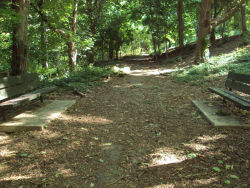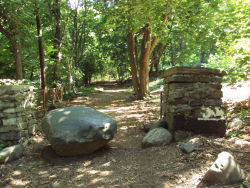Raoul Wallenberg Forest
Raoul Wallenberg Forest
What was here before?
This was the site of a rambling brick mansion erected in 1890 on a grassy hillside estate overlooking the Hudson River. It was built by world-renowned copper mining engineer and businessman, James Douglas (1837–1918). His daughter Elizabeth lived there until 1944.
In 1961 the United Nations rented the mansion for Burmese Diplomat and third Secretary-General U Thant (1909–1974) and his extended family. Thant was instrumental in defusing the Cuban Missile Crisis and in ending the civil war in the Congo. At his Spuyten Duyvil home, he conducted important UN business and entertained many domestic and foreign dignitaries. He lived in this home with his family until 1971. The mansion burned down and was demolished in 1974.
In 1987 the property was sold to a real estate developer who planned to build 28 single-family homes. To preserve the natural landscape as a community amenity, the citizens of Riverdale petitioned the City to preserve it as a public park.
How did this site become parkland?
This site was purchased by the City from a real estate developer on August 14, 1990. On November 28 of that year, Mayor David N. Dinkins (1927-2020) signed a bill naming the property after Raoul Wallenberg.
In 1996 the park was renamed Raoul Wallenberg Forest. It contains many venerable old-growth trees with trunks of large girth, including two—a white oak and a European beech—given the NYC Parks honorific "Great Trees". The site is also home to several densely vegetated areas of blackberries, wineberries, grapes, roses, Black locust and Sumac trees, and various wildflowers. It is designated a Forever Wild Forest Preserve.
Who is this parkland named for?
This parkland is named in honor of Raoul Gustav Wallenberg (1912–1947), a Swedish diplomat who is credited with saved tens of thousands of Hungarian Jews from likely extermination by the Nazis during World War II.
In 1944, the War Refugee Board appointed Raoul Wallenberg first secretary at the Swedish legation in Budapest. He designed counterfeit Swedish passports and distributed them on trains to Jews bound for concentration camps. He purchased as many houses, villas, and buildings as possible and adorned them with the blue and yellow colors of Sweden's flag, thereby making them neutral diplomatic property and safe havens for Jews. Wallenberg also organized and set up warehouses stocked with food to distribute rations to the needy, and to bribe Nazi officers. The Germans murdered hundreds of thousands Hungarian Jews during the war, but Wallenberg almost single-handedly saved as many as 100,000 Jews from likely death through his cunning and bravery.
On January 17, 1945, Wallenberg left Budapest to meet with Soviet military officials in eastern Hungary. This was the last time Wallenberg was ever seen in public. The Russian government claimed to have no knowledge of his whereabouts until 1957, when documents were released stating that Wallenberg had died of a heart attack in a Russian prison in 1947. To this day, Wallenberg's precise fate remains unknown.
Check out your park's Vital Signs
Clean & Safe
Green & Resilient
Empowered & Engaged Users
Share your feedback or learn more about how this park is part of a
Vital Park System



